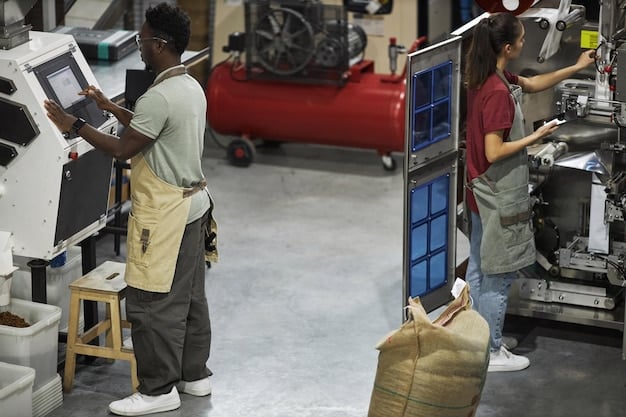E-Waste Recycling in the US: Understanding the Environmental Impacts

E-waste recycling in the US, while essential for resource recovery, can lead to environmental impacts such as soil and water contamination, air pollution, and health risks if not managed properly due to the presence of hazardous materials.
Electronic waste, or e-waste recycling in the US, is a growing concern due to the increasing volume of discarded electronics. While recycling aims to mitigate environmental damage, the process itself poses various threats that must be carefully understood and managed.
Understanding the E-Waste Challenge in the US
The proliferation of electronic devices has led to an unprecedented surge in e-waste. Understanding the scale and nature of this challenge is the first step toward addressing its environmental impacts in the US.
E-waste comprises discarded electronic products nearing the end of their lifespan; they range from smartphones and laptops to televisions and refrigerators. These products contain a mix of valuable materials like gold, silver, and copper, alongside hazardous substances such as lead, mercury, and cadmium. The environmental impacts of e-waste encompass pollution risks related to improper disposal, the resource depletion implications of not recycling, and the carbon footprint of producing new electronics to meet consumer demand.
The Scale of E-Waste Generation
The amount of e-waste generated annually in the United States is staggering, posing a significant environmental challenge.
- Volume: The US generates millions of tons of e-waste each year, making it one of the largest contributors globally.
- Growth Rate: E-waste is one of the fastest-growing waste streams worldwide, driven by rapid technological advancements and shorter product lifecycles.
- Collection and Recycling Rates: Despite increasing awareness, a relatively small fraction of e-waste is properly collected and recycled in the US, with a substantial portion ending up in landfills or being exported to developing countries.
The increasing volume of e-waste necessitates a more robust and effective recycling infrastructure to minimize its environmental footprint.
The Positive Environmental Aspects of E-Waste Recycling
E-waste recycling, when done correctly, confers major environmental benefits. By recovering valuable resources and minimizing the need for resource extraction, responsible e-waste recycling reduces pollution and promotes sustainability.
E-waste recycling enables secondary materials recovery for use in manufacturing operations. Electronic devices contain a variety of valuable and scarce materials, including gold, silver, platinum and rare earth elements. Recycling these substances reduces mining and refining operations, which are particularly impactful processes. Furthermore, recycling reduces pollution from improper disposal, prevents environmental damage from persistent toxic substances, protects human health, and reduces waste volumes requiring landfill disposal.

Resource Recovery and Reduced Mining
E-waste recycling fosters resource recovery, which mitigates the environmental impact of mining virgin materials.
- Valuable Metals: E-waste contains precious metals like gold, silver, and platinum, which can be recovered and reused in new products.
- Reduced Mining: Recycling e-waste reduces the need for mining these metals, which often involves environmentally destructive practices such as deforestation and habitat destruction.
- Energy Savings: Recovering materials from e-waste requires significantly less energy than mining and refining virgin materials, leading to lower greenhouse gas emissions.
By prioritizing resource recovery, e-waste recycling helps conserve natural resources and minimize the environmental footprint of electronic production.
In summary, the shift from depending on virgin materials to focusing on the reuse of recycled compounds promotes environmental protection, resource conservation, and sustainable economics. By effectively managing the resources contained within e-waste, both businesses and individuals can play a significant role in improving the state of the environment.
Soil and Water Contamination Risks
One of the most significant environmental concerns associated with e-waste recycling is the risk of soil and water contamination. Improper handling and processing of e-waste can release hazardous substances into the environment, posing serious threats to ecosystems and human health.
When e-waste is not properly handled, harmful substances leach into the soil and water and are subject to rainwater run off patterns. Exposure to these chemicals can occur through direct contact with contaminated soil or water, consumption of contaminated water, or inhalation of polluted dust. The heavy metals and toxic chemicals found in e-waste can accumulate in the environment over time, leading to long-term contamination that is difficult and costly to remediate.
Heavy Metals and Toxic Chemicals
E-waste contains a variety of heavy metals and toxic chemicals that can contaminate soil and water, causing severe environmental damage.
- Lead: Found in solder and CRT monitors, lead can cause neurological damage and developmental problems.
- Mercury: Used in LCD screens and batteries, mercury is a potent neurotoxin that can accumulate in the food chain.
- Cadmium: Present in rechargeable batteries and electronic components, cadmium is a carcinogen that can damage the kidneys and bones.
These substances can persist in the environment for long periods, posing ongoing risks to ecosystems and human populations.
By managing e-waste meticulously, by providing education about safe handling practices, and by developing robust protocols for managing e-waste flows, the United States can more effectively address and mitigate the dangers posed by soil water contamination through e-waste processing operations.
Air Pollution from Recycling Processes
E-waste recycling processes can release harmful pollutants into the air, contributing to air pollution and posing respiratory hazards. Inadequate emission controls and unsafe recycling practices exacerbate these risks.
Airborne particles and gases containing toxic chemicals released during e-waste shredding and open burning activities carry a significant public health risk. Residents in close proximity to recycling centers and processing facilities may be exposed to higher pollutant levels, raising the probabilities of developing both acute and chronic respiratory ailments like asthma and bronchitis. Furthermore, the dispersal of pollutants into atmospheric systems can cause extensive environmental damage, harming the purity of the air as well as damaging vegetation and ecosystems.

Burning and Shredding
Burning and shredding e-waste can release harmful pollutants into the air, impacting local and regional air quality.
Burning e-waste for material recovery releases toxic fumes, including dioxins and furans, which are highly carcinogenic and can cause a range of health problems. Shredding e-waste without proper ventilation or filtration systems can generate dust particles containing heavy metals and other hazardous substances, leading to respiratory irritation and long-term health risks.
To minimize air pollution from these actions, regulators must enforce stringent emissions controls and encourage recycling firms to engage in sustainable best practices. Effective air filtration systems, together with correct ventilation, can drastically reduce the emission of hazardous materials, thereby protecting the purity of the air. The adoption of stringent health and safety protocols and the utilization of automation may help to reduce human exposure to hazardous emissions and further enhance worker health protections overall.
Occupational Health Hazards for Workers
Workers in e-waste recycling facilities face significant occupational health hazards. Exposure to hazardous materials and unsafe working conditions can lead to various health problems, necessitating stringent safety measures and worker protection protocols.
Lack of appropriate protections such as gloves and masks is a problem that e-waste operations must address. Worker risks extend beyond direct chemical exposure; hazardous conditions are often present too, especially where labor is physically involved in breaking down electronics, removing parts and manually separating materials. Accidents involving machinery, falling or improperly stored objects, and other similar physical hazards must be taken in consideration.
Exposure Pathways
Workers in e-waste recycling facilities can be exposed to hazardous materials through various pathways.
- Inhalation: Inhaling dust particles and fumes containing heavy metals and toxic chemicals can cause respiratory problems and long-term health issues.
- Skin Contact: Direct contact with hazardous substances can lead to skin irritation, dermatitis, and absorption of toxins into the body.
- Ingestion: Accidental ingestion of contaminated materials can result in poisoning and other health complications.
Implementing comprehensive safety measures and providing adequate training and protective equipment are essential to protect workers’ health and well-being.
In conclusion, prioritizing worker safety by enforcing strict standards, delivering continuous training opportunities and carrying out frequent monitoring is essential for both the health and the ethical performance of the e-waste recycling sector. Workers, regulatory agencies and the broader communities will benefit from these initiatives. A collaborative strategy may create a work environment that supports both ecological sustainability and the welfare of employees.
The Role of Policy and Regulation
Effective policies and regulations are crucial for mitigating the environmental impacts of e-waste recycling in the US. Strong enforcement mechanisms and comprehensive frameworks can ensure responsible e-waste management and minimize harm to the environment and human health.
Federal regulations can establish a baseline against which e-waste recyclers and others operating on US soil must hold themselves. By embracing standardized criteria and regulations in recycling processes, regulatory requirements would contribute substantially to reducing the impacts associated with e-waste recycling on the environment, protecting both people and natural habitats from damage.
Extended Producer Responsibility (EPR)
Extended Producer Responsibility (EPR) policies hold manufacturers accountable for the end-of-life management of their products. The programs provide financial support for the collecting and recycling infrastructures and reduce the pollution load to which vulnerable communities find themselves exposed.
When producers have a financial stake in the management of e-waste, they tend to design products for recyclability, thereby decreasing the quantity of dangerous materials used in electronics. It inspires innovation of ecologically sustainable practices in recycling, like using novel technologies, to recover useful materials effectively. Producer responsibility programs can also create a circular economy where materials reclaimed from e-waste are used in the manufacturing of new goods. This circularity diminishes dependency on virgin materials, leading to resources being conserved as well as other reductions to mining operations.
For the future of e-waste management to be more sustainable, the development of integrated policy frameworks that emphasize producer responsibility is necessary. Through the promotion of extended producer responsibility (EPR) techniques lawmakers, recyclers as well as producers may better shield the environment, public wellbeing and support the shift to a more circular economy.
| Key Aspect | Brief Description |
|---|---|
| ♻️ Resource Recovery | Valuable metals are reclaimed, reducing the need for mining. |
| ⚠️ Soil Contamination | Heavy metals can leach into the soil, harming ecosystems. |
| 💨 Air Pollution | Burning e-waste releases toxic fumes, impacting air quality. |
| 🛡️ Worker Safety | Workers face exposure risks, necessitating protective measures. |
Frequently Asked Questions
▼
E-waste includes various electronic devices such as computers, televisions, mobile phones, and household appliances. These contain metals, plastics, and glass, some of which are hazardous.
▼
E-waste recycling is essential to recover valuable materials, reduce the need for mining, and prevent the release of hazardous substances into the environment, thus protecting ecosystems and human health.
▼
Improper e-waste disposal contaminates soil and water with heavy metals and toxic chemicals. It also contributes to air pollution during informal recycling processes, harming both the environment and public health.
▼
Consumers can participate in e-waste recycling programs, return old electronics to manufacturers, and support businesses that prioritize responsible e-waste disposal practices. This also pushes back against informal, unsafe recycling operations.
▼
The US has various state-level e-waste laws and promotes Extended Producer Responsibility (EPR). These policies aim to ensure manufacturers are responsible for the end-of-life management of their products, incentivizing recycling.
Conclusion
In conclusion, while e-waste recycling in the US offers significant benefits through resource recovery and reduced mining, it also poses considerable environmental challenges. Addressing these challenges requires a coordinated effort combining robust policies, responsible recycling practices, and increased consumer awareness to ensure a sustainable and safe approach to e-waste management.





